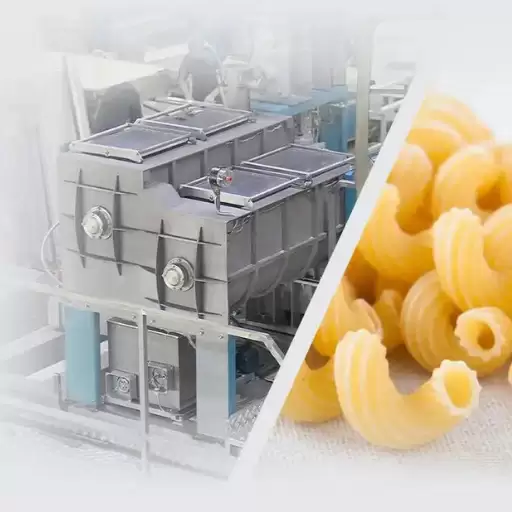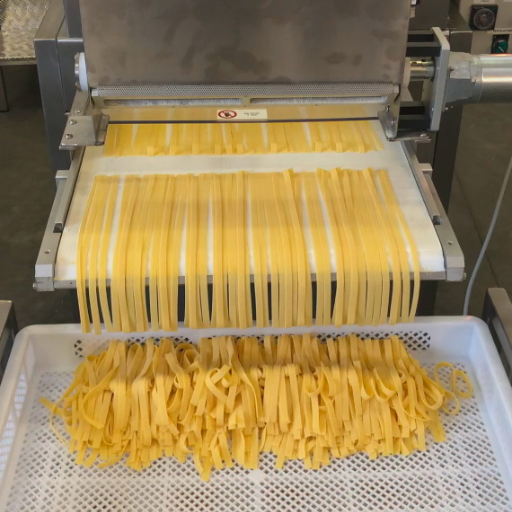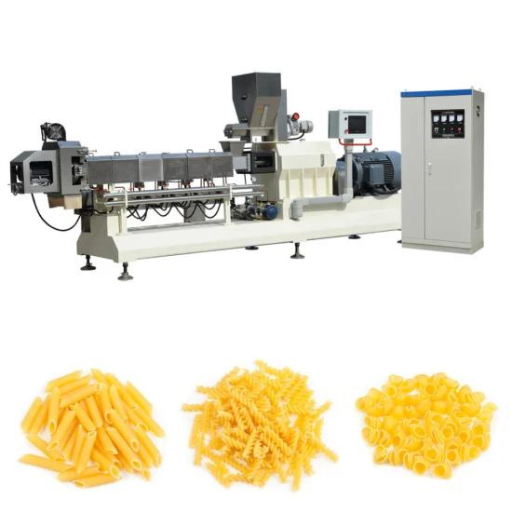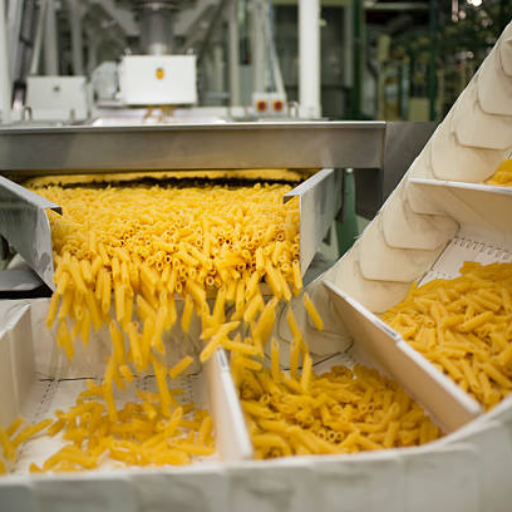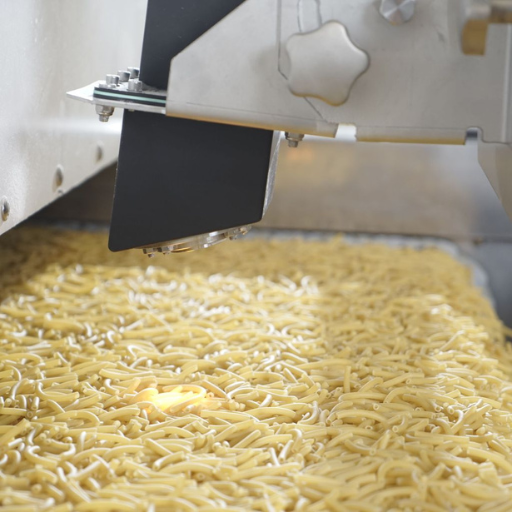When it comes to pasta production, having the right equipment is essential for maintaining quality and efficiency. In today’s competitive market, factories and restaurants alike must capitalize on modern innovations to stay ahead. This blog aims to provide you with an overview of the latest advancements in pasta processing equipment, detailing how these innovations can streamline operations, improve product consistency, and ultimately boost your bottom line. Whether you’re managing a large-scale factory or a boutique restaurant, understanding and implementing the best pasta processing solutions will help you deliver top-notch pasta dishes that keep customers coming back for more.
Understanding Pasta Processing Equipment in Modern Production
Essential Machinery for Fresh and Dry Pasta Production
In guaranteeing faultless pasta production, whether fresh or dry, a number of critical machinery are needed.
- Mixers and Kneaders: these machines are vital in blending together flour, water, and other constituents to come up with a homogeneous mass. The modern ones have accurate control settings that ensure uniform dough texture and composition.
- Extruders: these are used to shape the pasta dough into different designs such as spaghetti, penne or fusilli. The latest extruders have interchangeable dies and cutters which enables them to be quickly adapted to new types of pasta.
- Sheeters and Laminators: sheeters and laminators are crucial for pasta types like lasagna or ravioli. These machines roll out the dough into thin even sheets that can be sliced or filled accordingly.
- Drying Systems: For dry pasta production, efficient drying systems are essential so that it keeps its shape, taste while getting the desired amount of moisture content. Modern dyers provide an excellent control over temperature and humidity levels required for optimal drying processes.
- Pasteurizers: this is mainly employed when making fresh pasta because it improves its shelf life by killing all harmful microorganisms. Advanced pasteurizers use specific temperature controls to maintain its quality and safety standards.
- Cutting Machines: these machines cut the dough into various shapes and sizes. This makes them critical in custom made as well as standard shapes of pastas.
- Cooling and Storage Systems: Pasta often needs cooling after drying or pasteurization in order to keep its quality highduring storage thus extending shelf life. With advanced cooling systems enabling fast uniform cooling; storage solutions optimize conditions before packaging takes place.
- Packaging Machines: Finally, packaging machines play a critical role in protecting pasta during transit and display. Automated packing systems offer speed with accuracy thereby ensuring end products reach consumers in perfect condition.
This not only increases productivity but also guarantees adherence to high standards for quality and reliability in the final product by adopting the latest pasta processing equipment. These advancements can significantly improve operations and give a competitive advantage in today’s business world.
Differentiating Between Various Types of Pasta Machines
To differentiate various types of pasta machines, it is important to understand what they are used for in pasta making process. Here are the main types of pasta machines:
- Manual Pasta Machines: these machines often have a basic hand crank mechanism and are suitable for home use. They help to roll out dough and cut it into different shapes such as fettuccine or spaghetti. Some popular brands include Marcato Atlas and Imperia.
- Electric Pasta Machines: being user-friendly, electric pasta machines simplify much of the rolling and cutting process therefore they are good for both home cooks and small businesses. Many models come with several attachments designed to make different kinds of pasta. Philips and Nuvantee are reputable companies that sell such devices.
- Extrusion Pasta Machines: these are industrial-grade appliances used in large scale production. They use dies to push dough through making complex designs such as penne, rigatoni or macaroni. Pavan as well as Bühler mainly specialize on extruders with large capacities which are intended for mass-production.
- Pasta Sheeters: these appliances particularly roll out large sheets of pasta dough that may be cut into various shapes or employed in dishes like lasagna. They form an integral part of commercial kitchens known for their accuracy, so their products always have similar characteristics
- Ravioli Makers: These machines deal in the manufacture of stuffed pastas like ravioli. They take away the need for manual placing of stuffing and sealing of two dough layers hence speeding up production. Machines from Tecna and Dominioni are also commonly used by many in the manufacturing industry.
- Pasta Drying Machines: For commercial production, these machines perfect drying phase of pasta making process. It is important to ensure uniform drying as this affects product quality and extends shelf life. Companies such as Italgi and Clextral offer state-of-the-art technologies for drying.
By understanding these various types of machines that make pasta, a manufacturer will be in a position to select an appropriate machine according to his specific needs thus minimizing inefficiency and inconsistency when it comes to pasta products.
The Role of Extruders and Sheeters in Pasta Making
Extruders and sheeters play significant roles during the process of making pasta especially for commercial purposes; extruders use a piston or rotating screw fitted inside a barrel attached with pasta plates through which the doughs are pressed to obtain different shapes like penne, spaghetti, rigatoni among others. The reason behind this is that one can produce many kinds of paste having same cooking time required; this enhances consistency during cooking processes. Similarly, sheeters consistantly roll out large even sheets of dough before cutting them into fettuccine et al., or using them as layers in lasagna instead; these sheeters make flat thin crusts which are ideal for some recipes. Consequently, these machines have increased efficiency while maintaining high standards in terms of commercial production therefore manufacturers can meet varied demands within their markets.
The Significance of Choosing the Right Pasta Machine
What to Consider When Choosing Industrial Pasta Machines
There are various technical parameters and important factors to be considered in selecting industrial pasta machines in order to guarantee the best performance and product quality:
- Capacity and Throughput: Determine how much pasta you need to produce. The output capacities of these industrial machines vary greatly, with some machines producing hundreds of pounds per hour while others can produce tens of tons per hour, which necessitates an accurate determination of the production capacity required to assist in choosing a suitable machine.
- Type of Pasta: Variety in pasta products that will be made. Different machines are made for different shapes and sizes of pastas. For instance, extruders are ideal for shaped pasta like penne and spaghetti whilst sheeters are better suited for flat pasta like lasagna and fettuccine.
- Material of Construction: The type of material used is crucial since it impacts both food safety as well as durability. Stainless steel is commonly used because it does not corrode easily and it is easy to clean enabling easy adherence to hygiene standards
- Automation Level: What level automation am I looking for? Advanced features such as automated dough mixing, extrusion, cutting, drying etc. that reduce manual labor and improve efficiency come with high end machines. Some have programmable logic controllers (PLCs) for precision purposes as well as ease of use.
- Energy Consumption: How energy efficient are they? This may result into large reductions on costs incurred during operations as well minimizing environmental impact by using energy efficient machines. Look at their energy ratings or compare power consumption among different models.
- Maintenance and Support: Are there maintenance services available? This makes after sales support highly reliable while also ensuring availability of spare parts that help minimize downtime thereby elongating the life span of these machines.
- Cost: Financial limitations play a role too. Though higher-end machinery may come with advanced features; it is important to strike a balance between price tag characteristics needed vis-à-vis what one needs to produce.
- Brand Reputation: Check for reputation and reliability of the manufacturer. Italgi, Clextral, Buhler…these are just some examples of companies that produce pasta machines with great warranties and awesome customer service.
- Compliance with Standards: Ensure adherence to local and international food safety and quality standards such as FDA, CE, and ISO certifications. This ensures their safety as well as conformance to industry regulations.
- Space and Layout: Examine the space available in the production area. The physical dimensions pasta machines must never interfere with other production operations within the area they are placed. Machines that use little space but are efficient in terms of arrangement should be considered.
By considering these things carefully, producers can select exactly the right pasta machines needed for their specific production requirements thus increasing efficiency in operation as well as quality of product.
From Ravioli to Gnocchi: Specialized Machinery for Unique Pasta Shapes
The most popular machines for making gnocchi have rollers with grooves, which create the recognizable ridges and adjustable cutters that make different sizes. The GN2 machine from Italgi is an example of such a machine since it can be used for different types of doughs including potato, ricotta or even gluten-free gnocchi. On the other hand, Clextral’s screw extruders that rotate in the same direction at high speeds can also produce artisan-quality gnocchi having superior texture and shape retention.
Specialized pasta machines like these are built to meet strict hygiene standards, using stainless steel components and easy-to-clean designs. They are fully automated to streamline production processes, reduce manual labour and increase productivity. Through specialized ravioli and gnocchi machines manufacturers can make vast assortments of pasta shapes without altering the quality or consistency of their products.
Commercial vs. Industrial Pasta Equipment: What’s Best for Your Business?
Production volume, budget constraints and specific needs are some of the factors that will help you decide on whether to choose commercial or industrial pasta equipment for your business.
For commercial purposes, small to medium-sized operations such as restaurants, cafes may use Commercial Pasta Equipment while small scale home-based pasta making enterprises operate under this category too. These machines are generally cheaper to purchase; they are also more portable and user-friendly. They offer companies a wide range of possibilities by allowing them to switch between molds in order to produce diverse kinds of pastas in various sizes as well as forms. Nonetheless, commercial equipment usually has certain limitations regarding capacity as compared with its counterparts within the industrial sector hence necessitating manning from human beings unlike heavy machinery that operates automatically throughout.
Industrial Pasta Equipment is designed specifically for large-scale manufacturing environments such as commercial pasta factories and big food processing plants. These machines have considerably higher levels of robustness than those produced earlier since they operate continuously producing millions of tonnes per annum at few breakdowns. They are highly automated with features such as continuous dough mixing, high-speed extrusion and automated cutting and drying systems. Thus, industrial equipment is employed in companies that aim at huge volumes and consistent quality of the product. However, these machines have high capital costs, large space requirements and sophisticated maintenance regimes.
In conclusion, if you run a small or medium-sized pasta business that emphasizes on artisanal quality and flexibility then commercial pasta equipment would be the right option for you. Industrial pasta equipment would be more appropriate for those businesses that target mass production at low cost.
Technological Advancements in Pasta Production Equipment
The Impact of Automation on Pasta Manufacturing
Pasta manufacturing automation has been revolutionized by a great deal of enhanced effective, consistent and scalable processes. These include continuous dough mixing, high speed extrusion, automatic cutting and drying, all integrated in advanced automated systems. Thus there is little need for human intervention or manual error. This saves money and ensure that the production is even. Furthermore, such technological advancements in the manufacturing systems allow for faster productions rates without compromising on quality to meet growing demand. Also real time monitoring and data analytics support optimization, energy efficiency as well as reducing waste during production processes. As a result of these developments pasta makers are now better prepared to tackle an ever changing market by streamlining operations while at the same time increasing general productivity.
Innovative Features in Modern Pasta Processing Machinery
In order to improve its productive capacity modern pasta processing machinery has several innovative capabilities geared towards improving efficiency, quality of product as well as flexibility of operation. Some of these include advanced extrusion techniques which results in uniformity and precise shapes when making pasta using these machines. Moreover optimal dryers that have controlled humidity levels and temperature settings are used so that efficient drying process takes place so that the texture and flavor will be maintained when cooking this pasta; High-performance dryers with controlled humidity levels and temperature settings provide optimal drying processes, preserving the pasta’s texture and flavor.. Similarly numerous machines have been fitted with highly developed sensors plus control systems which enable them to check constantly on things hence they can make corrections where necessary thus ensuring that their products remain standard throughout including in terms of resources usage.. Again by integrating it with the IoT (Internet of Things) technologies it becomes easy for manufacturers to be warned about potential breakdowns through preventive maintenance programs ultimately minimizing downtimes increasing lifetimes.. Consequently any contemporary small scale or mass producer who intends to compete requires access to such recent technologies innovating into this sphere.
How Continuous Pasta Production Enhances Efficiency
Continuous pasta production is the most efficient way to produce this foodstuff because it eliminates delays and ensures that nothing comes between production. In other words, a continuous process of making pasta involves a combination of mixing, kneading, extruding, drying and cutting stages. Continuous production systems can therefore produce larger quantities of pasta with uniform quality at lower labor costs through reduced manual intervention. Further -it uses less energy per unit output compared to batch processing thus it is cheaper and has a lower environmental burden.. With real-time monitoring and advanced control systems each step can be optimized so as to minimize losses during manufacturing by managing the resources efficiently. By that way manufacturers are able to quickly ramp up their supplies while keeping product lines excellent thanks to uninterrupted manufacturing cycle.
Therefore, continuity in pasta manufacturing leads to high productivity through interrupted workflow minimizing downtimes enhancing scalability throughout the process, that is, from mixing doughs to cutting tubes into pieces for use in finished products.
Optimizing Pasta Factory Operations with Advanced Equipment
Efficiency through the Integration of High-Volume Pasta Production Lines
Integration of high-volume pasta production lines significantly improves operational efficiency and product output. This integration requires sophisticated equipment such as high capacity mixers, continuous extruders and multiple zone dryers. Mixing ingredients thoroughly ensures that all are blended together properly to maintain reliably good quality using high capacity mixers. Continuous extruders easily simplify pasta shaping by providing uniformity and reducing work done by hand. Multizonedryers make it possible for drying conditions to be regulated accurately in order to get desired texture and shelf life.
Optimization of these processes hinges on technical parameters which are involved in them.Technical details like speed rate for an extruder ranging between 300-500 kg/hour are important so that they can meet the needs of large scale production while a multi-zone dryer should keep its temperature at the range of 60°C – 90°C depending on the type of pasta being used. The monitoring system plays a significant role where sensors determine moisture content, dough density, and temperature at different stages to give confidence about quality control. Moreover, IoT integration enhances predictive maintenance whereby servicing is required based on usage data thus reducing downtime since automatic scheduling of equipment service can take place with its help.
To sum up, this paper has shown that advanced technology and specific technical parameters enable pasta manufacturers to unlock efficiencies within their operations while making their products more superior in quality. These solutions allow consumers’ preferences to be met thus remaining competitive in a changing market environment.
Gnocchi et al: Personalized Solutions for Nonstandard Pasta Shapes
In order to make custom solutions for non-standard pasta forms like gnocchi special machinery and techniques need to be available. Higher end gnocchi machines have been made specifically with soft doughs in mind which results in every piece being identical in both size as well as texture. These machines often come with functionalities that include adjustable rolling pressure speeds plus cutting speeds to ease production of multi-recipes. In addition to this, automated dough feeding systems and accurate water dosing systems can also be used thus increasing consistency and quality of produced gnocchi.
For other unique pasta forms, custom molds and dies are a must. These tools allow for shapes with complicated designs that target niche markets in gourmet applications. Furthermore, these customized moulds can be generated using sophisticated software that is concerned with the specific aesthetic and functional features.
In addition, quality control is important. IoT enabled monitoring systems provide the real time information about the production metrics whereas techniques like the optical sorting and weight verification are also useful in maintaining standards. This will lead to adjustments as soon as possible thus reducing wastages since it ensures every batch of special pasta should meet the required high quality standards.
In brief, specialized equipment, customized molds and advanced monitoring systems enable efficient production of high-quality gnocchi as well as other unique pasta forms by manufacturers. Consequently, these solutions facilitate innovation in pasta making enabling them to address different consumer needs while remaining competitive within their chosen market segments.
How Multifunction Pasta Processing Systems Can Be Used To Maximize Productivity
Maximizing productivity when producing pasta involves employing multifunctional pasta processing systems that can streamline different stages of manufacturing process. Advanced versions encompass several functions such as mixing, kneading extrusion drying within one unit thereby eliminating separate machines or manual interventions during operation. In order to maintain consistent high speed outputs without compromising on quality automation plays a very key role here though.
Modern PLC’s (Programmable Logic Controllers) and HMI’s (Human-Machine Interfaces) are incorporated into today’s pasta processing systems for precise management of production parameters. Thereby ensuring each batch meets all set stringent quality specifications with smallest possible variation between lots which require minimal adjustments if any at an installation site due its rapid changeover characteristics hence modular design facilitates easy switching over from one kind or shape into another thus increasing operational flexibility.
The fact remains that such systems are capable of cutting down on downtime and maintenance expenses. This implies that there would be minimum interruptions if self-cleaning mechanisms as well as those parts which can be replaced easily were installed. In addition, energy efficient technologies and maximum resource utilization help in saving costs and sustainability.
In summary, multi-role pasta production plants are vital for firms that want to increase their productivity level, sustain high standard of quality and respond quickly to the market demand. Manufacturing firms can gain a competitive edge while at the same time producing a variety of pasta products that meet consumer tastes through these innovations.
From Dough to Dish: The Journey of Pasta Making Equipment
How to Navigate Through The Dough Preparation Stage with the Right Machines.
Choosing the right machines for dough preparation is key in maintaining uniformity of quality and efficiency. Key considerations and technical parameters that one should look out from insights from top websites have been provided below.
- Kneading Machines: The first must-have machine is a kneader, which helps to blend all ingredients together properly. These machines usually come with features like spiral or planetary mixing systems, variable speed controls etc. to ensure even blending. To optimize on its performance, you need to go for models having minimum power of 1.5 kW and heavy stainless steel bowl.
- Dough Sheeters: A dough sheeter flattens dough at various heights depending on the desired thickness. A good model could include adjustable rollers catering for different preferences in thickness plus a conveyor belt system ensuring continuous production takes place. One would require rolls that can be adjusted from 1 mm up to 40mm width in order to have an ideal machine in mind.
- Dough Dividers and Rounders: These are devices used for portioning and shaping dough into equal parts. Consistency requires high precision cutting tools as well as automatic weighing systems among others. An excellent dough divider has less than 2g deviation per piece thus accuracy should be beyond question at all costs.
- Fermentation Chambers: Some types of pasta undergo fermentation process before they become ready for cooking. In these chambers, the temperature and humidity levels are controlled so that dough rises perfectly well in them.It is worth looking out for chambers that maintain constant temperatures (+/- 1°C deviation) as well as relative humidity (+/-2% deviation).
- Extruders: An extruder is indispensable if you are producing any kind of extruded pasta shapes including macaroni or spaghetti noodles.Extruders nowadays are modular-based with quick-change dies allowing for fast swapping between products.Technical parameters important here may be motor power (minimum 2 kW) and throughput capacity (up to 200 kg/h).
In your production line, each piece of equipment should be capable of being integrated well without any hitches; hence it is important that it can handle different types of pasta, as well as batches. The aim is to achieve a balance between efficiency, quality and adaptability to cope with diversified consumer demands.
Cutting and Shaping: Precision Tools for Perfect Pasta
To achieve consistent and high-quality results in cutting and shaping pasta, precision tools are necessary.The main tools you require are shaped molds, noodles cutters or rollers. These help ensure every noodle piece has equal sizes and shapes that are vital in cooking consistency as well as looking good when served. Advanced cutters will come with adjustable settings allowing you to choose the width and thickness of your pasta in relation to various recipes you want to try out. Moreover, utilizing mold shapes helps you create complicated designs for your spaghetti making which make it superior compared to others. Investing in accurate tools will improve the pasta’s overall performance.
The Crucial Role of Drying and Cooking in Pasta Quality
Drying processes are necessary for preventing spoilage while preserving shape and texture.Proper drying at controlled temperatures gradually ensures that the structure remains intact even after boiling thus preserving its taste too.It is very relevant for one to properly dry his/her dough so that it doesn’t become spoiled during storage; also one would not like a situation where his/her dough disintegrates upon contact with water!
Timing and water temperature are of utmost importance while cooking. Apart from ensuring that the pasta does not get mushy or lose its nutritional value, cooking pasta al dente also provides a crunchy texture. Boiling water in a big pot of enables it to cook uniformly and absorb the correct amount of moisture which improves its quality as a whole.
This is what will enable the final product to always taste good, feel good and be bought by everyone.
Reference sources
- Pamaroma: Lines and Equipment for Pasta Factories
- URL: https://www.pamaroma.com/lines-and-equipment-for-pasta-factories/
- Summary: This website provides comprehensive information about various pasta manufacturing machines, including extruders, dough sheeters, and ravioli makers. It covers both small-scale and industrial-scale equipment, making it a valuable resource for both restaurant owners and factory managers. The detailed descriptions and specifications help users understand the capabilities and applications of each machine.
- Relevance: Ideal for factory owners looking for specific equipment to enhance or set up a pasta production line. Pamaroma is known for its high-quality Italian pasta manufacturing equipment, adding credibility to the source.
- GEA: Dry Pasta Processing Equipment
- URL: https://www.gea.com/en/products/pasta-snacks-breakfast-cereals/dry-pasta-processing/
- Summary: GEA offers turnkey automated manufacturing lines for various types of pasta, including long and short-cut dry pasta, as well as fresh pasta. This source outlines the complete processing equipment needed for different pasta types, highlighting the efficiency and technological advancements in pasta manufacturing.
- Relevance: Useful for large-scale factories seeking to implement advanced, automated systems for pasta production. GEA’s expertise in engineering and technology ensures that the information is both accurate and cutting-edge.
- Bühler Group: Pasta Production Technology
- URL: https://www.buhlergroup.com/global/en/industries/Pasta.html
- Summary: Bühler Group provides an extensive range of pasta production technologies, including dough mixers, dryers, and optical sorters. Their focus on innovation and quality control makes this source particularly valuable for those interested in the latest technological advancements in pasta manufacturing.
- Relevance: Bühler’s reputation in the food technology industry reinforces the reliability of the information. The site is particularly beneficial for factories aiming to integrate state-of-the-art technology into their pasta production processes.
Frequently Asked Questions (FAQs)
Q: What are the key innovations in pasta factory machines that could benefit my factory or restaurant?
A: Innovations in machines for pasta factories focus on flexibility, high-quality production, and efficiency. Key advancements include double sheet pasta machines for high volume pasta production, tailor-made solutions for specific pasta shapes like cavatelli and foglie d’olivo, and machines designed to ensure the high-quality output of ready meals. Collaboration with technology leaders such as GEA, known for its comprehensive insights into the food processing industry, can provide access to cutting-edge solutions.
Q: How do commercial pasta sheeters contribute to the process of making pasta?
A: One of the important things that pasta sheeters do in a commercial setting is to make sure that they flatten dough evenly until it reaches the thickness desired. Uniform pasta sheets are essential because they will be later shaped into different types of pastas or cutted. Commercial pasta lines address the demand for producing large amounts of pastas in factory settings and restaurants with high turnover by ensuring a uniform thickness as well as quality in their products.
Q: Which factors should I take into account when buying a cooker for my factory or restaurant?
A: For your operations involving cooking of pasta consider your projected volumes, typical dishes you would like to serve and need for consistent quality at point of consumption. Cookers tailored towards an increased demand for pasta come with proper cooking facilities and are integrated within cold chain operations making them ideal for ready meals and big hotels looking forward to having top-notch quality plus efficiency.
Q: In factory what size flour particles will be suitable? What kind of flour should be used?
A: The choice concerning flour size and type is crucial in achieving desired quality in paste. High protein durum wheat semolina flour is commonly used due to its gluten strength as well as elasticity which makes it easy to make varieties of pastas. Flour particles should be homogeneous and fine enough so that the dough will be smooth and malleable. This way, the resultant product meets textural as well as gustatory standards required by industrial activities of significant scale and picky consumers.
Q: What about machines for production meant especially for my kind of pasta and its volume?
A: The inclusion of bespoke accessories and adjustability features allows customization of machines for production according to specific pasta types and production volumes. Shandong Loyal Machinery Co., Ltd., a manufacturer, has a wide variety of customizable pasta machinery that can make an array of traditional pastas through regional specialties. By assessing your production needs, machine suppliers can recommend and configure the machines with the appropriate cutter, moulds, and extrusion plates to match your desired pasta variety and volume requirements precisely.
Q: Do flexible machines for pasta factories exist? How can they benefit me?
A: They can easily adapt to different types of pasta production in the factory without experiencing significant downtime or adjustments. Factories use these machines to quickly switch from one pasta shape or size to another, run short or long batches for certain types of pasta and also incorporate new accessories for a variety of pasta shapes. When it comes to expanding their range of pasta dishes and promptly adjusting to market variations, flexible machinery is highly productive as well as accommodative.












